Boston Latin School
The Boston Latin School is a public exam school in Boston, Massachusetts. It was established on April 23, 1635, making it both the oldest public school in America and the oldest existing school in the United States.[3][4][5][6] The Boston Latin School was a bastion for educating the sons of the Boston "Brahmin" elite, resulting in the school claiming many prominent New Englanders as alumni. Its curriculum follows that of the 18th century Latin school movement, which holds the classics to be the basis of an educated mind. Four years of Latin are mandatory for all pupils who enter the school in the 7th grade, three years for those who enter in the 9th grade.
| Boston Latin School | |
|---|---|
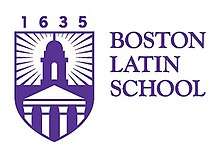 Logo as of 2019 | |
| Address | |
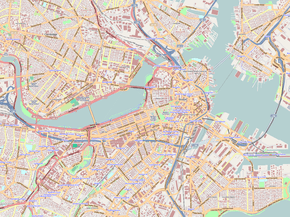 Boston Latin School 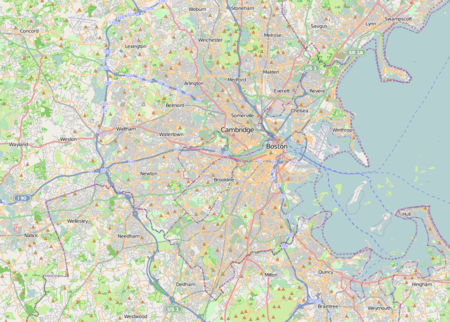 Boston Latin School  Boston Latin School  Boston Latin School | |
78 Avenue Louis Pasteur , Massachusetts, 02115 United States | |
| Coordinates | |
| Information | |
| Type | Public exam school |
| Motto | Sumus Primi (Latin) ("We are first") |
| Established | April 23, 1635 |
| School district | Boston Public Schools |
| Headmaster | Rachel Skerritt |
| Teaching staff | 117.17 (FTE)[1] |
| Grades | 7–12 |
| Gender | Coeducational |
| Number of students | 2,453 (2017–18)[1] |
| Student to teacher ratio | 20.94[1] |
| Campus | Urban |
| Color(s) | Purple and White, |
| Athletics conference | Massachusetts Interscholastic Athletic Association (MIAA) District A – Dual County League |
| Mascot | "Wolfie"[2] |
| Nickname | "The Wolfpack", "BLS" |
| Rival | English High School of Boston (Boston English) |
| Accreditation | New England Association of Schools and Colleges (NEASC) |
| Newspaper | The Argo |
| Yearbook | Liber Actorum |
| Website | bls.org |
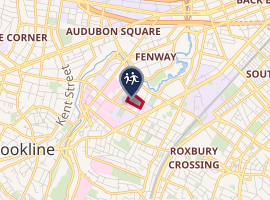
| |
History


Boston Latin School was founded on April 23, 1635 by the Town of Boston.[7][8] The school was modeled after the Free Grammar School of Boston in England under the influence of Reverend John Cotton.[9] It was intended to educate young men of all social classes in the classics.[10][11][12] The school was initially funded by donations and land rentals rather than by taxes.[13] A school established in nearby Dedham was the first tax-supported public school.[13]
Latin is the mother of modern Romance languages and was an educational priority in the 17th century.[14] The ability to read at least Cicero and Virgil was a requirement of all colonial colleges, and to write and speak Latin in verse and prose was the first of the Harvard laws of 1642.[15][16] Boston Latin prepared many students for admission to Harvard,[17] with a total of seven years devoted to the classics.[18] However, most graduates of Boston Latin did not go on to college, since business and professions did not require college training.[19]
In May 2009, Boston Latin School closed for one week due to the H1N1 outbreak.[20]
In 2015, Boston Latin School had 2,400 pupils drawn from Boston. It has produced four Harvard University presidents, four Massachusetts governors, and five signers of the United States Declaration of Independence. Benjamin Franklin[21] and Louis Farrakhan[22] are among its well-known dropouts.
The School began as the South Grammar School[23] and was specifically modeled after the Boston Grammar School in Lincolnshire, England.
The Latin School admitted only male students and hired only male teachers from its founding in 1635 into the 19th century. Helen Magill White was the school's first female graduate and the first American woman to earn a doctorate. Magill White was the only female pupil at the school when she attended. The Girls' Latin School was founded in 1877, and Boston Latin admitted its first co-educational class in 1972.[24]
The school appointed Marie Frisardi Cleary[25] and Juanita Ponte[26] as the first two women in its academic faculty in 1967. Cornelia Kelley was the school's first female headmaster, serving from 1998 until her retirement in 2007,[27] after which Lynne Mooney Teta became headmaster.[28] In 2016, Mooney Teta resigned amid a federal probe into racially charged incidents at the school.[29] In 2017, Rachel Skerritt became the first person of color to serve as headmaster.[30]
A cadet corps was founded during the American Civil War; it was disbanded in the early 1960s.[31]
Location history
| Photo | Point | Coordinates (links to map & photo sources) |
Notes |
|---|---|---|---|
 |
First Boston Latin School House. Circa 1635. Ezekiel Cheever was an early head master of the Boston Latin School. He taught for seventy years, the last thirty-eight as master of the Boston Latin School. | 42.367800°N 71.059877°W | [32][33] |
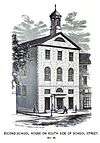 |
Second BLS school house on south side of School Street. 1812–1844. | 42.357640°N 71.059679°W | [34][35] |
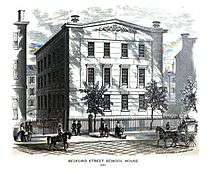 |
Third BLS school house on Bedford Street, 1844–1881. | 42.353840°N 71.061060°W | [36][37][38] |
 |
Fourth location of BLS school house in Warren Avenue, (shared with the English High School of Boston), 1881–1922. | 42.344178°N 71.073380°W | [39][40] |
 |
Fifth site of BLS school house on Avenue Louis Pasteur. 1922–present. | 42.338017°N 71.102016°W | [41] |
Academics
Boston Latin's motto is Sumus Primi, Latin for we are first. This is a double entendre, referring both to the school's date of founding and its academic stature. Boston Latin has a history of pursuing the same standards as elite New England prep schools while adopting the egalitarian attitude of a public school. Academically, the school regularly outperforms public schools in affluent Boston suburbs, particularly as measured by the yearly MCAS assessment required of all Massachusetts public schools. In 2006, Brooklyn Latin School was founded in New York City, explicitly modeled on Boston Latin, borrowing much from its traditions and curriculum.[42]
Admissions
Admission is determined by a combination of a student's score on the Independent School Entrance Examination (ISEE) and recent grades, and is limited to residents of the city of Boston.[43] Although Boston Latin runs from the 7th through the 12th grade, it admits students only into the 7th and 9th grades.
Because it is a high-performing and well-regarded school, Boston Latin has been at the center of controversy concerning its admissions process. Admissions are very competitive, and it is not uncommon for fewer than 20% of applicants to be admitted. Before the 1997 school year, Boston Latin set aside a 35% quota of places in its incoming class for under-represented minorities. The school was forced to drop this policy after a series of lawsuits involving non-minority girls who were not admitted despite ranking higher than admitted minorities.[44][45] Boston Latin subsequently defeated a legal effort to do away with its admissions process entirely and conduct admissions by blind lottery. The percentage of under-represented minorities at Boston Latin fell from 35% in 1997 to under 19% in 2005, despite efforts by Boston Latin, the Boston Public Schools, and the Boston Latin School Association to recruit more minority applicants and retain more minority students.
Curriculum
Declamation is the most time-honored of the school's traditions. Pupils in the 7th through 10th grade are required to give an oration, known as 'Declamation', in their English class three times during the year. There is also Public Declamation, where pupils from all grades, or classes, are welcomed to try out for the chance to declaim a memorized piece in front of an assembly. During Public Declamation, declaimers are scored on aspects such as "Memorization" "Presentation", and "Voice and Delivery", and those who score well in three of the first four public declamations are given the chance to declaim in front of alumni judges for awards in "Prize Declamation".
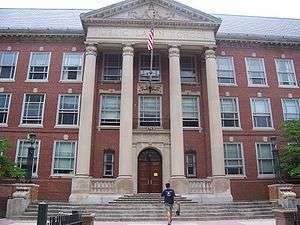
In addition to the well-known and time-honored tradition of declamation in English classes, recently the Modern Languages department instituted an annual "World Language Declamation" competition. Once a year, during National Foreign Language Week (usually the first week of March),[46] students from grades 8 through 12 perform orations in languages other than English. Most students choose to declaim in the modern language they are studying, though some choose Latin, Greek, or their native tongue. Judges are brought in from various institutions around the city, and mark the students in similar categories to those used in Public Declamation. Entrants are categorized by level, rather than language, such that all students declaiming at the first-year level of various languages are competing against each other, all students at the second-year level compete against each other, and so on. Students who regularly perform exceptionally well at World Language Declamation are honored at Prize Night with the Celia Gordon Malkiel Prize.[47]
In a move that was controversial among some alumni, the school decided in 2001 to decrease the requirement for students' Latin instruction by one year, starting with the class of 2006.[48] The mandatory minimum period of Latin instruction was decreased for students admitted for 7th grade from five years to four years, and for students admitted for 9th grade from four years to three years. This decision was made by the head of the school's Latin department, in recognition of the fact that the requirement was hampering students' ability to take enough courses in important modern subjects such as Physics, Chemistry, Computer Science and modern languages. However, students can still take Latin courses after their fourth year, in AP Latin and Latin 5, the latter if there is demand. Greek is additionally an option.
In a 1789 codicil to his will, Benjamin Franklin established a legacy to fund the Franklin Medals, which are awarded to the school's top-ranking pupils at graduation. The second most prestigious awards, the Dixwell Prizes, are given to pupils excelling in Latin or Greek.
Publications
There are currently three main publications of the Boston Latin School: The Register is the school's literary magazine, The Argo the school newspaper, and Catapulta is the school science magazine. George Santayana founded The Register in 1881 to serve as the school newspaper. Over the years, however, it evolved into a purely literary magazine, publishing prose and poetry written by members of the student body, as well as artwork. There are generally three editors-in-chief, and it is published twice per year. The Argo, the school's newspaper, is far younger, having been founded in 1970 after it was clear that the Register had become a purely literary magazine. As of the 2006–2007 school year, it is published seven times a year. Catapulta, the science magazine, highlights popular and recent science and technology and is generally published four times a year. The Register, the Argo, and Catapulta are entirely student-produced, and the "Argo" and the "Register" have won awards from the New England Scholastic Press Association, while Catapulta has won awards from the American Scholastic Press Association.[49]
Another Boston Latin publication is "BLSA Bulletin", published by the Boston Latin School Association, whose president is Peter G. Kelly, '83.[50]
Athletics

Boston Latin's teams are known as the Boston Latin Wolfpack; their colors are purple and white. Boston Latin has played rival Boston English in football every Thanksgiving since 1887,[51] the oldest continuous high school rivalry in the United States.[52]
The school has fielded several successful sports teams, including the fencing team, sailing team, cross country team, indoor and outdoor track teams, boys and girls volleyball team, the boys and girls crew teams, the boys and girls swimming and diving teams, baseball, softball, wrestling, boys and girls soccer, boys and girls hockey, and cheerleading.
However, the football team has not won its league or made the playoffs since 1987.
In the spring of 2014, Boston Latin launched its varsity boys lacrosse as well as varsity girls lacrosse, the only public school in Boston with lacrosse. In the spring of 2017, in just its third season as a varsity sport, the girl's lacrosse team made the state tournament for the first time.
In the winter of 2015, Boston Latin launched its varsity boys fencing as well as varsity girls fencing, the only public school in Boston with fencing.
In the winter of the academic year 2015–16, the school's varsity fencing team took home the state championship title for the first time ever, with the men's team placing second overall and women's fourth overall.
In the spring of 2019, the school's boys varsity volleyball team took home its first DCL championship title since 2006.
Performing and Fine Arts
Boston Latin's Arts Department offers courses as well as ensembles for its students to join.
The school offers Visual Art class and a Music Fundamental class for 7th graders as well as a Theatre class for 8th graders for students who are not enrolled in any other form of art. The department also offers higher-level Visual Art classes in the 11th and 12th grades and the option to take AP Art for students who demonstrate proficiency in this discipline. An additional Theatre Studies course can be taken in these grades as well, covering the history and styles of theatrics.
Latin School's Performing Arts provide opportunities for students from the 7th to 12th grade to learn and develop musical technique, as well as learn music theory in a classroom setting through AP Music Theory. The ensembles offered vary from beginner to high-level groups that compete at local and state competitions. Among the Performing Arts students have the option to participate in Chorus, Strings, Band, and Theatre (both in and out of school). The school's Wind Ensemble, Symphonic Band, Concert Strings Orchestra, and Concert Choir have received Gold Medals at MICCA competitions in the past. Extracurricular ensembles such as the Dues Band and Show Choir also compete for medals.
The Boston Latin School Big Band also competes in the Charles Mingus High School Jazz Festival, as well as the Essentially Ellington competition. Although they have not won the Ellington Competition, the band was one point off from being a Finalist in 2017. The band has been a Finalist in the Mingus Festival in 2017, 2018, 2019, and 2020, winning the Non-Specialized High School category in 2018.
In popular culture
- In "Six Meetings Before Lunch", a first-season episode of The West Wing, Rob Lowe's character Sam Seaborn mentioned Boston Latin School in a discussion of public school reform and school vouchers in American public education. He said, “Boston Latin, the oldest public school in America, is still the best secondary school in New England.” Mallory O'Brien replies "They all can't be Boston Latin and Bronx Science."
- On January 8, 2002, President George W. Bush visited the Boston Latin School after signing the No Child Left Behind Act earlier that day.[53]
- In Season 1, Episode 12 of Studio 60 on the Sunset Strip, Matthew Perry's character Matt Albie mentioned that his nephew had a 3.8 GPA at Boston Latin.
- In the 2008–2009 school year, former vice president Al Gore visited Boston Latin School and commended the students for their hard work educating the community about making environmentally respectable decisions.
Alumni
Boston Latin has graduated notable Americans in the fields of politics (both local and national), religion, science, journalism, philosophy, and music. Of the 56 men who signed the Declaration of Independence, five were educated at Latin: Adams, Franklin, Hancock, Hooper, and Paine.[54] Graduates and students fought in the Revolutionary War, American Civil War, World War I, World War II, Korean War, and the Vietnam War, and plaques and statues in the school building honor those who died.
Hall of Fame
The Hall of Fame, known casually as "The Wall," refers to the upper frieze in the school's auditorium, where the last names of famous alumni are painted. These names include Adams, Fitzgerald, Franklin, Hancock, Hooper, Kennedy, Mather, Paine, Quincy, Santayana, Winthrop, and many others. The most recent name, Wade McCree Jr., was added to the frieze in 1999, and the selection of the name involved a conscious effort to choose a graduate of color.[55] There are no names of female graduates, mostly because women have attended the school for just 46 years and the honor is only bestowed posthumously. There is also a lower frieze with the names of many other distinguished graduates, and a place on the lower frieze can be awarded while the person is still alive.
Names
The school is commonly known as BLS or Latin School.
Rankings and awards
In 2007, the school was named one of the top 20 high schools in the United States by U.S. News & World Report magazine.[56][57] It was named a 2011 "Blue Ribbon School of Excellence", the Department of Education's highest award.[58] As of 2018, it is listed under the "gold medal" list, ranking 48 out of the top 100 high schools in the United States by U.S. News & World Report.[59]
In 2019, the school was rated the school as the top high school in the Boston area by U.S. News & World Report and number 33 in national rankings.[60]
See also
References
- "Boston Latin". National Center for Education Statistics. Retrieved January 4, 2020.
- Caldwell, Dave (2006-11-10). "Thanksgiving Day Games: Old Rivalries, Then the Turkey". The New York Times. Retrieved 2008-01-12.
- "History of Boston Latin School—oldest public school in America". Boston Latin School. Archived from the original on 2007-05-02. Retrieved 2007-06-01.
- "Boston Latin School". Encyclopædia Britannica Online.
- "First Public School Site and Ben Franklin Statue". City of Boston.
- "Boston Latin School". NNDB.
- "BLS History". www.bls.org. Retrieved 2020-04-15.
- "Boston Latin School | American secondary school". Encyclopedia Britannica. Retrieved 2020-04-15.
- "BLS History". www.bls.org. Retrieved 2020-04-15.
- Jeynes, William H. (2007). American educational history : school, society, and the common good. Thousand Oaks, Calif. [u.a.]: SAGE Publications. pp. 4, 6, 12. ISBN 978-1412914215. Retrieved 6 March 2016.
- Simon, Christopher A. (2001). To run a school : administrative organization and learning. Westport, Conn.: Praeger. p. 8. ISBN 978-0275968342.
- "Boston Latin School | American secondary school". Encyclopedia Britannica. Retrieved 2020-04-15.
- Sacchetti, Maria (November 27, 2005). "Schools vie for honor of being the oldest". The Boston Globe. Retrieved June 14, 2016.
"In Boston everybody may have agreed that education was important, but nobody put his wallet on the table," said Robert Hanson, Dedham's former executive secretary and the unofficial historian.
- Howe, Françoise Waquet. Translated by John (2002). Latin or the empire of a sign : from the sixteenth to the twentieth centuries (Paperback ed. 1. publ. by Verso. ed.). London: Verso. p. 22. ISBN 978-1859844021. Retrieved 6 March 2016.
- "History of Harvard". AllAboutHistory.org. Archived from the original on 16 March 2016. Retrieved 6 March 2016.
- Morison, Samuel Eliot (1968). The founding of the Harvard College. Cambridge, Mass.: Harvard University Press. p. 333. ISBN 978-0674314504. Retrieved 6 March 2016.
- Meckler, ed. by Michael (2006). Classical antiquity and the politics of America : from George Washington to George W. Bush. Waco, Tex.: Baylor Univ. Press. p. 18. ISBN 978-1932792324. Retrieved 6 March 2016.CS1 maint: extra text: authors list (link)
- Wright, Conrad Edick (2005). Revolutionary generation : Harvard men and the consequences of independence. Amherst [u.a.]: Univ. of Massachusetts Press. p. 26. ISBN 978-1558494848. Retrieved 7 March 2016.
- Reese, William J. (1999). The origins of the American high school. New Haven: Yale University Press. p. 3. ISBN 978-0300079432.
- "Suspected swine flu closes Boston Latin, other schools". May 19, 2009.
- "Benjamin Franklin". Exodus Provisions.
- John B. Judis (August 18, 1996). "Maximum Leader". The New York Times. Retrieved 2006-05-19.
- Publications of the Colonial Society of Massachusetts, Volume 27. Colonial Society of Massachusetts. 1932. p. 135. Retrieved 11 March 2016.
- https://www.nytimes.com/1972/09/10/archives/girls-admitted-by-boston-latin-allboys-school-drops-its-bar-after.html
- Marie Frisardi Cleary (May 19, 1985). "The Halls of Boston Latin School". The New York Times. Letter to the editor.
- Bergeron, Amanda (July 21, 2007). "Juanita Ponte, 62; taught at Boston Latin". Boston Globe. Retrieved 2007-07-21.
- Jan, Tracy (2007-02-14). "Boston Latin headmaster to retire". Boston Globe. Retrieved 2007-12-31.
- "Assistant head is named to Latin's top job". Boston Globe. June 26, 2007. Retrieved 2007-07-04.
- Vaznis, James; Staff, Jan Ransom Globe; June 21; 2016; Comments, 3:10 p m Email to a Friend Share on Facebook Share on TwitterPrint this Article View. "Amid controversy, Boston Latin headmaster resigns - The Boston Globe". BostonGlobe.com. Retrieved 2019-07-11.CS1 maint: numeric names: authors list (link)
- "Rachel Skerritt: The First POC Headmaster of the Country's Oldest Public School". Her Campus. Retrieved 2019-07-11.
- Hank Brandli (September 30, 2004). "Boston School Cadets". The Bulletin. Retrieved January 8, 2018.
- 42.357909°N 71.059798°W
- (Estimated from: Plan of Boston showing existing ways and owners on December 25, 1635. Author: Lamb, George. 1635 Location: Boston (Mass.))
- Boston 1842 "Boston" from Tanner, H.S. The American Traveller; or Guide Through the United States. Eighth Edition. New York, 1842
- 42.357640°N 71.059679°W (Estimated from Tanner map)
- Catalogue of the Boston Public Latin School, Established in 1635: With an Historical Sketch, Henry Fitch Jenks. Boston Latin School Association. 1886. Pages 94–95.
- Map title: Map of Boston, 1865 Photographically Reduced From City Engineer Plans With All The Latest Improvements. A Complete Guide To Strangers. Publisher: L. Prang & Co. Date: 1865
- 42.353840°N 71.061060°W (Estimated from Prang & Co. map)
- Catalogue of the Boston Public Latin School, Established in 1635: With an Historical Sketch, Henry Fitch Jenks. Boston Latin School Association. 1886. Page 303.
- 42.344178°N 71.073380°W (Estimated from description in Jenks, page 75)
- SCHOLA LATINA BOSTONIENSIS CCCL ANNOS NATA. (BOSTON LATIN AT 350). April 21, 1985. Boston Globe. By John Powers
- Jan, Tracy (March 4, 2006). "Growing a Boston Latin in Brooklyn". Boston Globe. Retrieved 2007-08-31.
- "Answers to Frequently Asked Questions about Entrance to Boston Latin School" (PDF). Archived from the original (PDF) on 2008-02-29. Retrieved 2007-12-31.
- See: Wessmann v. Gittens, 160 F. 3d 790 – Court of Appeals, 1st Circuit 1998 s:SARAH P. WESSMANN, p.p.a. HENRY ROBERT WESSMANN, v. ROBERT P. GITTENS, CHAIRPERSON OF THE BOSTON SCHOOL COMMITTEE, ET AL., and McLAUGHLIN BY McLAUGHLIN v. Boston School Committee, 938 F. Supp. 938 F.Supp. 1001 (1996) Civil Action No. 95-11803-WAG. United States District Court, D. Massachusetts. s:938 F.Supp. 1001 (1996) Julia A. McLAUGHLIN, by Catherine McLAUGHLIN, Plaintiff, v. BOSTON SCHOOL COMMITTEE, et al., Defendants.
- "The Boston Latin Case". Center for the Study of Testing, Evaluation, and Educational Policy. Archived from the original on 2007-08-08. Retrieved 2008-01-29.
- Kate Stevenson (2008). National Foreign Language Week
- Prizes and Scholarships, BLS Web Site
- Vaishnav, Anand (2001-04-13). "Boston Latin Eases Language Requirement". Boston Globe. Archived from the original on April 16, 2001. Retrieved 2007-12-31.
- "Publications—Argo". BLS Web Site. Archived from the original on 2007-09-27. Retrieved 2007-06-01. Includes scans of first Argo edition, 1969.
- "BLSA Bulletin". Boston Latin School Association. Fall 2008.
- Werchadlo, Emily (2005-11-24). "It's still defined by Latin and English". Boston Globe. Retrieved 2008-01-29.
- Dahlbeck, Dwayne (2007-11-27). "Latin's first conquest comes at last". Boston Globe. Retrieved 2008-01-29.
- "President Bush Speaks in Boston". CNN.com. 2002-01-08.
- Rauseo-Ricupero, Ronaldo (2002-01-09). "Bush Comes To Boston After Education Victory". Harvard Crimson. Retrieved 2007-12-31.
- Hill, Tony (2000-11-12). "To Place a Black Man in Latin's Pantheon: An Alumnus Quietly Raised to the Star-Studded Frieze". Boston Globe.
- "Best High Schools 2008". U.S. News & World Report. November 29, 2007. Archived from the original on December 18, 2008.
- "The First-Class State—Two examples of how Massachusetts gets it right". U.S. News & World Report. November 29, 2007. Archived from the original on December 19, 2008.
- 2011 National Blue Ribbon Schools, accessed April 3, 2012
- "National Rankings Best High Schools". U.S. News & World Report LP. 2016-04-19. Archived from the original on 2016-04-20. Retrieved 2016-04-20.
- Reiss, Jaclyn (2019-06-12). "These are the best high schools in the Boston area, according to US News & World Report". The Boston Globe. Retrieved 2019-06-12.
External links
| Wikimedia Commons has media related to Boston Latin School (Boston, Massachusetts). |
- Official website

- Catalogue of the Boston Public Latin School, Established in 1635: With an Historical Sketch, Henry Fitch Jenks (1886)
| Preceded by King's Chapel Burying Ground |
Locations along Boston's Freedom Trail Boston Latin School |
Succeeded by Old Corner Bookstore |